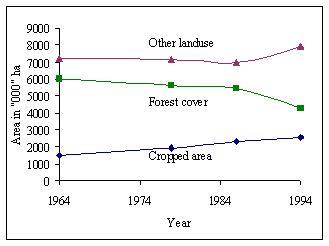


Nepal is very rich in natural resources. It is second in the world in terms of water resources and twenty-fifth in biodiversity, with 118 ecosystems, 75 vegetation types and 35 forest types. About 370 identified species of flowering plants are considered endemic to Nepal and about 700 species are known to possess medicinal properties.
However, the needs of a growing population are adversely affecting the sustainability of its natural resources. Forests play a vital economic, social and environmental role in Nepal but have deteriorated over time. Forest cover has shrunk from 45 percent in 1964 to 29 percent in 1994. Anthropogenic disturbance has threatened the existence of more than 60 species. The diversion of forest land for resettlement, roads, academic institutions and other development activities as well as encroachment, illicit felling and excessive grazing are adversely affecting the extent, productivity, and sustainability of forest resources (Ninth Plan, 1998).

The forestry sector in Nepal is doing its best to meet its dual responsibility of making an increased contribution to the gross domestic product while conserving bio-physical resources, even with a limited amount of funding. Many forestry sector programmes such as community forestry, lease-hold forestry, pasture development, soil and water conservation, conservation of protected areas and development of markets for non-wood forest products are being implemented in selected locations with increased participation of the people. Attempts are being made to extend this participatory mode of management to Protected Areas for biodiversity conservation.
Forest management and development plans have been developed for a number of areas but they have yet to be implemented. This has resulted in poorer results than expected in terms of rehabilitation, production, number of forest industries, employment and overall contribution to the economy from the forestry sector. Further, there is little scientific information regarding the distribution, harvesting, storage, marketing, cultivation and management of most of the non-timber forest products found in Nepal. The Ninth Five Year Plan (1998) attributes this condition to lack of proper allocation and attention to the forestry sector.
There is a significant divergence in perception of the rural people and the urban residents about forest resources. Like other South Asian countries, the urban areas in Nepal are generally distant from the forest and are occupied by people that have a greater set of choices and alternatives and often have little knowledge of or dependency on forest resources than rural people (Ninth Plan, 1998). The rural people value forests more as source of physical goods for day-to-day consumption
than for environmental services. The urban people derive their valuation of forests from macro level environment oriented information sources and accordingly value forests more for environmental services than for physical goods.
The Five Year Plans (FYPs) recognize the complexity of the forestry sector and call for a holistic approach and a mix of strategies to translate government policies into administrative and managerial actions. The FYPs clearly state the goals of the government for sustainable development and scientific utilization of forest resources in accordance with liberal economic policies. The current (Ninth Plan, 1998) Five Year Plan supports the national goals of increasing economic growth, reducing poverty, narrowing regional imbalances and sustaining natural resources. In addition, it proposes additional resources to meet targets, improved institutional mechanisms, better inter-ministerial co-ordination, stronger enforcement of laws and regulations and additional training and career development opportunities.
Mater Plan of the Forestry Sector (MPFS, 1988) has an integrated, coordinated, programmatic approach with enhanced partnerships and mutual co-operation between governmental, communities and non-governmental entities. The MPFS aims at enhanced and sustainable supply of forest products like timber, firewood, fodder and NTFPs to meet the basic requirements of Nepalese people. The other objectives of MPFS include conservation of land and its cover from soil erosion, floods, landslides, desertification and other environmental imbalances, preserving biological and genetic resources and supporting the national economy through development of industries based on forest goods and services.
Increased level of compatibility between framework of forestry development and that of economic development has increased the potential of sustenance of forest resources in Nepal. However, enhanced social, political and financial commitment is necessary to effectively harness this potential.